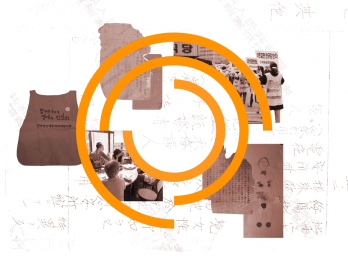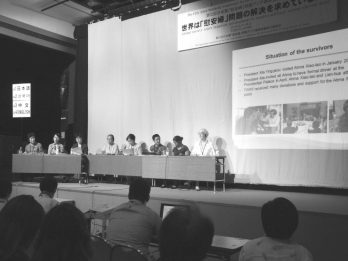
In Timor-Leste, a small island near Indonesia, many supporters are working to amplify the voices of the Japanese Military “Comfort Women” victims, who have been marginalized amid government indifference and social stigma. Meanwhile, a professor in the United States across the Pacific is teaching university courses on the history of “Comfort Women,” a subject rarely mentioned in textbooks, and emphasizes that society can stop violence against women by facing the dark sides of the past. Furthermore, some argue that making the history of “Comfort Women” an international official record is crucial to prevent the repetition of such an unfortunate history.
Bringing the invisible victims back to the center of attention and recognizing the “Comfort Women” issue as a universal human rights issue for everyone living in the present, rather than a past issue of a few, is the starting point of the “Comfort Women” discourse. In commemoration of the 2024 International Memorial Day for Japanese Military “Comfort Women,” the webzine Kyeol introduces various movements made at home and abroad to bring the Japanese Military “Comfort Women” issue, which has lingered on the periphery of history, to the forefront as a core agenda of women’s rights.
For the Joint Nomination of Documents on the Japanese Military “Comfort Women” to UNESCO Memory of the World (MoW) Register (2)
Criteria for Inscription in the UNESCO MoW Register
To be registered as UNESCO Memory of the World (MoW), a record must document a historically significant event and meet the criteria of “world significance.” This “world significance” pertains to the record’s “historical narrative” and must fulfill the following six criteria: Time, Place, People (individual achievements), Subject/Theme, Form and Style, and Social, Spiritual, and Community Significance.
The “Time” criterion requires that the document reflect a period of value change in human society, representing that era uniquely or being essential for understanding a historically significant period. The “Place” criterion demands that the document provide regional information about an event in a specific area that has contributed to world history or cultural development. The “People” criterion requires that the document be associated with individuals who have made significant contributions to world history or culture. The “Form and Style” criterion necessitates that the document display exceptional aesthetic values. Additionally, a record meeting all the criteria above must hold historical significance socially, mentally, and culturally within a specific cultural context over time. It must also be authentic, rare, unique, and irreplaceable. Finally, the document must be of such significance that its loss or damage would result in a substantial loss to humanity’s memory and heritage to qualify for inscription.
The classification of documents related to the history of Japanese Military “Comfort Women” and their eligibility for inscription in the UNESCO MoW Register depends on how that history is defined. When the subject is a proud historical record from a single nation, such as the Veritable Records of the Joseon Dynasty or the Hunminjeongeum, inscribed in 1997, a single category of records is typically involved for inscription. However, for complex issues like the Japanese Military “Comfort Women,” where overlapping factors such as war and colonization are involved, the categorization of records can become a potential source of conflict. This is because such records often seek to represent different historical narratives from both the victims’ and perpetrators’ perspectives.
The history of the Japanese Military “Comfort Women” cannot be fully represented through government documents and other written records alone. To create a “complete history,” it is essential to include non-written records, such as the “memories” embodied by the victims, alongside the so-called “official documents” produced in the language of empires or those in power. Notably, in 2002, UNESCO revised its guidelines to expand the definition of documentary heritage to encompass a wide range of media and formats, including written, unwritten, visual, digital, and virtual records. This decision reflects a global commitment to remembering the histories of socially and politically marginalized groups.
The World Significance of the History of Japanese Military “Comfort Women”
The Japanese Military “Comfort Women” issue, as is widely known, involved the forced mobilization of women by Japanese soldiers, officials, and military police, both directly and indirectly, from around the time of the Mukden Incident in 1931 until the end of the Asia-Pacific War. These women were subjected to physical and psychological slavery in comfort stations established within Japanese military bases or near battlefields, resulting in profound and irreparable harm to countless women, particularly in the Asia-Pacific region. Had this issue been recognized solely as an event of World War II, it might have remained just one among many wartime incidents. In reality, despite being a grave issue of wartime rape and sexual slavery, the Japanese Military “Comfort Women” issue was neglected until its truth was more widely acknowledged and discussed.
The reasons why the International Committee for Joint Nomination of Documents on the Japanese Military “Comfort Women” to the UNESCO Memory of the World Register (ICJN) seeks to inscribe these records as a UNESCO documentary heritage have much to do with changes in the international community. The courageous public testimonies of the victims and the changes created and advanced by the victims and global civil society, such as evolving values regarding wartime sexual violence and women’s human rights and the growing awareness of peace driven by women’s power, align with the ultimate aspirations of our human society.
After Korean victim Kim Hak-sun publicly testified in 1991, many other victims worldwide began to come forward, prompting global citizens to engage in civic movements to uncover the truth and seek justice. Not only the victim countries but also the Japanese government, the country directly concerned, have recognized through truth-seeking efforts and victim testimonies that the sexual violence perpetrated by the Japanese military was systematic, continuous, and recurrent, acknowledging the severe human rights violations involved. This issue gained significant attention at the 1993 Vienna World Conference on Human Rights and the 1995 Beijing World Conference on Women. Ultimately, the issue of wartime violence against women, including the Japanese Military “Comfort Women,” was reflected in the 1998 Rome Statute of the International Criminal Court (ICC), contributing to establishing rape, sexual slavery, forced pregnancy, and enforced sterilization as punishable war crimes and crimes against humanity.
The history of the Japanese Military “Comfort Women” issue has challenged long-standing conservative cultural norms regarding women and sexuality in Asia by amplifying the voices of the victims. Moreover, it has contributed to the establishment of globally significant norms and values related to women’s human rights. This means that the records documenting the Japanese Military “Comfort Women” issue and related activities meet the criteria of “world significance.”
Furthermore, because the issue is directly linked to sexual violence, it is often considered taboo in official settings, with persistent risks of documents being concealed or systematically destroyed to deny the atrocities committed against the Japanese Military “Comfort Women.” The loss or destruction of these records could significantly lose humanity’s memory and heritage, especially the strengthened values of women’s human rights since the 1990s. This is a compelling reason why the Japanese Military “Comfort Women” records should be registered as the UNESCO MoW.
Scope and Classification of Japanese Military “Comfort Women” Records for Inscription
Meanwhile, the ICJN, which has been discussing the scope of materials for registration, decided to include all Japanese Military “Comfort Women” records identified to date. It compiled a list of records held by public institutions such as national archives, document repositories, museums, and libraries across various countries and then contacted these countries and institutions to confirm their willingness for joint nomination and to obtain permission. Additionally, it reached out to private organizations and privately established museums and conducted a thorough investigation of privately held materials.
As a result, the Imperial War Museum London in the UK agreed to the joint nomination, becoming a partner institution with the ICJN. Approval for the nomination was received from 20 public institutions, including the archives from eight ICJN member countries and those from the US, Australia, and the UK. Additionally, two private museums and two individual collectors also permitted their materials to be included in the application. In total, 2,744 records were submitted for inscription.
The ICJN has defined the history of the Japanese Military “Comfort Women” from the period of the 1931 Mukden Incident to the human rights restoration movement led by the victims and global citizens. Based on this definition, the related records are classified into three categories: (1) Official and private documents that provide information on the Japanese Military “Comfort Women” system; (2) Documents produced by the victims; (3) Records of civil society movements aimed at resolving the issue. The details are as follows:
② Documents produced by victims: This category encompasses materials generated by the victims after 1990, including testimonies, witness statements, medical records, and drawings and artworks created during psychotherapy. A total of 1,449 records fall under this category.
③ Documents of civil society movements: This category has been compiled, focusing on the most impactful activities of the 14 organizations included in the ICJN. A total of 732 records fall under this category.
In 2016, the ICJN held a second meeting with experts in UNESCO MoW and archival studies to select the materials for nomination. The discussions focused on the criteria of “originality” and “authenticity” of the victim testimonies. Key issues included determining which testimony should be considered the original when a victim had given multiple accounts and how to assess the “authenticity” of testimonies as required by UNESCO MoW, mainly when a testimony contained details that might not fully align with historical facts.
Based on the opinions of the experts who participated at the time, UNESCO MoW considered each testimony an “original” record, even if a victim recounted the same events multiple times or with slight variations because each testimony held its own significance. While consistency with historical facts is crucial for historical research, the MoW prioritized preserving records that captured the victim’s “memory.” Therefore, these records were regarded as possessing “authenticity.” In other words, as long as the fact of being a victim of the Japanese Military “Comfort Woman” remained unchanged, the issue was viewed as one of media diversity rather than content accuracy.
Assessment as “Unique and Irreplaceable Records” and “Politicization”
Before the UNESCO Memory of the World (MoW) Executive Board adopted the revised guidelines in 2022 to strengthen regulations on state involvement, joint nomination applications by multiple states, such as those submitted by the ICJN, could be directly submitted to the UNESCO MoW website without going through a national commission. Once the UNESCO Secretariat received the nomination, it was reviewed by the Register Subcommittee (RSC) under the International Advisory Committee (IAC), a group of experts who assessed whether the application met the criteria for UNESCO MoW inscription. The IAC then considered the RSC’s findings and made a recommendation to the UNESCO Director-General, who made the final announcement regarding the inscription.
In May 2015, the ICJN applied to the UNESCO MoW website, listing 2,744 records under the title “Voices of ‘Comfort Women’.” During the preparation process, several suggestions were made, including condemning the Japanese government’s insufficient efforts to address the issue, using the term “sexual slaves” to describe the victims, and recognizing the issue as a form of “genocide,” comparable to the Holocaust in Germany. After consulting with experts, the Japanese Military “Comfort Women” Victims Support and Commemoration Project Team decided to exclude content related to the Japanese government in the application to avoid it being perceived as “political.” Similarly, although “sexual slaves” was considered accurate, the term “sexual slavery-like conditions” was used instead to prevent Japan from politicizing the matter.
However, it was soon discovered that certain organizations from Japan and the United States had submitted a joint nomination application with the aim of obstructing the inscription of the Japanese Military “Comfort Women” records into UNESCO. As anticipated, the review process for the inscription proved to be challenging.
On April 17, 2017, the RSC reported that the “Voices of ‘Comfort Women’” records were assessed as “unique and irreplaceable.” However, the RSC expressed concerns about the comparisons made in the application between the Japanese Military “Comfort Women” issue and the Holocaust or the Cambodian genocide. The RSC advised that such comparisons were inappropriate, given that the role of the UNESCO MoW program is to register documents, not to interpret history. Consequently, it was recommended that the comparison be removed and the application resubmitted. It was also reported that if the application were revised and resubmitted, it would be forwarded to the IAC, and the “UNESCO Director-General would then announce a decision on new inscriptions to the Register based on the advice provided by the IAC during its September 2017 meeting.”
The ICJN concluded that the inscription of the Japanese Military “Comfort Women” records would sufficiently demonstrate Japan’s criminality without needing to compare them to the Holocaust or the Cambodian genocide in the application. Consequently, following the RSC’s recommendations, it revised the application and submitted the final version on April 23, 2017.
At the time, the ICJN was optimistic about the joint registration of the records as UNESCO World Documentary Heritage, given that the RSC had already assessed them as “irreplaceable and unique.” However, the ICJN recognized that the Japanese application was being pushed forward with strong involvement from the Japanese government and anticipated that Japan would use robust diplomatic measures to pressure the UNESCO Secretariat. Consequently, it decided to proceed with the process proactively and in strict accordance with principles while carefully accommodating UNESCO’s feedback.
Related contents
-

- Voices of “Comfort Women”: A Global Civic Movement for Memory
-
The suffering of the Japanese Military “Comfort Women,” one of the most tragic human rights abuses of the 20th century, should be preserved and managed as historical documentary heritage. This is crucial to prevent such atrocities from recurring and provide a lesson to future generations.
-

- The supranational nature of the 'comfort women' issue and the ‘glocalization’ of memories, Part 1
-
Written by Shin Ki-young, Professor at Ochanomizu University, Japan
-

- The supranational nature of the 'comfort women' issue and the ‘glocalization’ of memories, Part 2
-
Written by Shin Ki-young, Professor at Ochanomizu University, Japan
- Writer Hye-in Han
-
Hye-in Han is a Research Fellow at the Asia Peace & History Institute, where her research focuses on historical disputes and dialogue. Since 2014, she has been an active member of the project team for the “International Committee for Joint Nomination of Documents on the Japanese Military ‘Comfort Women’ to UNESCO Memory of the World Register.”
hanhi822@gmail.com